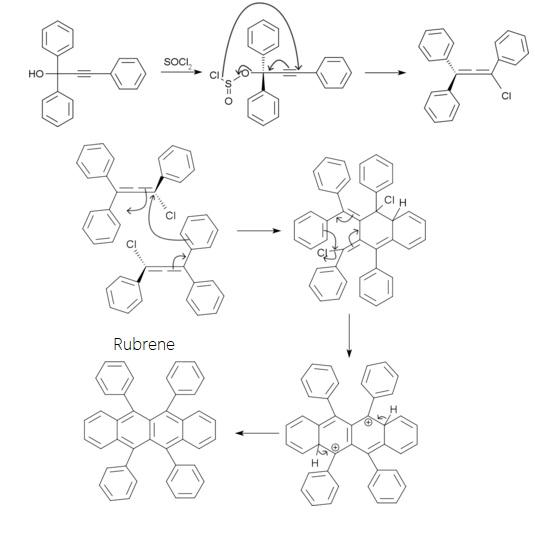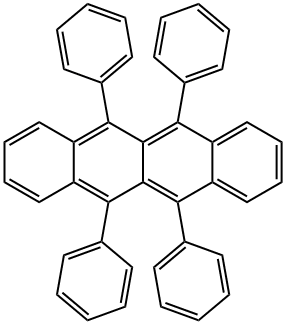Rubrene, a molecule with a tetracene backbone and four appended phenyl rings, is one of the most studied molecular semiconductors due to its high charge mobility. Notably, room-temperature hole mobilities of the order of 20-40 cm2V-1s-1 have been measured for rubrene in single-crystal organic field-effect transistors (SC-OFET). It is widely used in organic electronics, especially organic light-emitting diodes (OLEDs) and organic field-effect transistors (OFETs).
Rubrene is an organic semiconductor used in organic light-emitting diodes (OLEDs) and organic field-effect transistors. It is used as a sensitizer in chemoluminesence. It is also used to prepare single crystal transistors. It acts as a reagent for chemiluminescence research and for transition metal complex ligation. Further, it is used as a p-type organic semiconductor.
Rubrene is an organic molecule that has long been known for its outstanding semiconductor performance in organic electronic devices.
Rubrene is prepared by treating 1,1,3-triphenylprop-2-yne-1-ol with thionyl chloride.

The resulting chloroallene undergoes dimerization and dehydrochlorination to give rubrene.
Rubrene is a tetraphenyl derivative of tetracene that is used as an organic semiconductor. It is used as a source material in the fabrication of rubrene single crystal based transistors with carrier mobility over 10 cm2V?1s?1.
It has also been recrystallised from *benzene under red light because it is chemiluminescent and light sensitive. [Beilstein 5 IV 2968.]
Structure and conformation
The rubrene molecule is basically the tetracene molecule with four wings. Its family are the polycyclic aromatic hydrocarbons. When rubrene molecules combine to build orthorhombic crystals, the molecules have a centrosymmetric structure with 2/m symmetry, as shown in the figure (their tetracene backbone acquires a twist when the molecules are free from constrains). Symmetry considerations imply that transitions between electronic ground state and first excited state can only be mediated by electromagnetic radiation that is polarized parallel to the 2-fold symmetry axis of the molecule (the M axis), which is in the plane of the tetracene backbone and perpendicular to its long axis.
https://www.lehigh.edu/~inlo/rubrene.html




